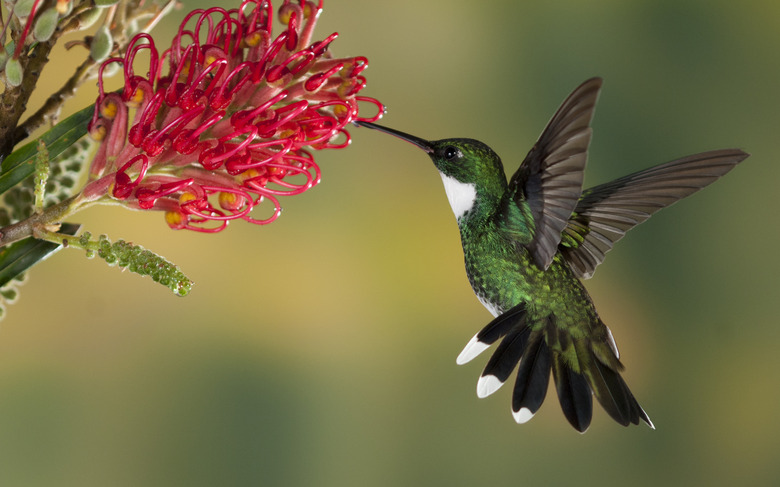Life Cycle Of The Hummingbird
Known for their rapid heartbeats and speedy flights, the life cycle of a hummingbird is busy. Hummingbird eggs are cared for solely by the female, who does everything from building the nest and keeping the eggs warm to feeding her hatchlings until they are big enough to look after themselves. Male hummingbirds spend their days foraging for food and searching for mates during the breeding season.
Hummingbird Foraging
Hummingbird Foraging
Hummingbirds spend most of their time foraging for nectar and small insects. They need constant energy supplies in order to maintain their rapid wingbeats, which range from ten to 15 beats per second in Giant Hummingbirds (Patagona gigas) and up to a whopping 70 to 80 beats per second in smaller species. Hummingbirds use their rapid wingbeats to reach flight speeds of up to 28 miles per hour.
These fast wingbeats are paired with fast heart rates: at rest a hummingbird can reach a heart rate of 500 to 600 beats per minute. When active, this skyrockets to over 1000 beats per minute. For comparison, a human's heart beats 60 to 100 times per minute while resting and can reach up to 150 beats per minute while exercising.
Hummingbird Sizes
Hummingbird Sizes
The smallest hummingbirds, like Bee Hummingbirds (Mellisuga helenae), usually weigh less than 0.07 ounces and, as adults, can grow to a length of between 2.17 and 2.41 inches. Adult Giant Hummingbirds weigh between 0.67 and 0.74 ounces and reach lengths of 7.87 and 8.66 inches.
Most hummingbird species weigh between 0.09 and 0.23 ounces, with lengths ranging from 2.36 to 4.72 inches. Despite their tiny size, hummingbirds typically live between six and twelve years in the wild.
Hummingbird Courtship
Hummingbird Courtship
Male hummingbirds are usually elaborately colored and have decorative plumage with long tail feathers to help them find females to mate with. The male hummingbird sings and flutters or dives in dramatic flight patterns, displaying his beautiful plumage to attract females.
Some male hummingbirds are territorial and defend their singing posts or display grounds from other males. Other hummingbird species – like the Wedge-tailed Sabrewing (Campylopterus curvipennis) – display lekking behavior, which means the males group together for flight or song displays.
During mating season, a male hummingbird will mate with multiple females. The female may mate with more than one male before laying her eggs in her nest. A female hummingbird can have up to two broods in a year. Females are usually sexually mature at one year old.
Hummingbird Eggs
Hummingbird Eggs
Before courtship, the female hummingbird makes a nest as tiny as a bottle cap using found materials such as leaf litter, small branches and lichens. The nests are often held together with spider silk or pine resin. After copulation, she will typically lay two small white eggs in her walnut shell-sized nest. Hummingbird egg sizes range from 0.315 to 0.433 inches for tiny bee hummingbirds and 0.472 to 0.787 inches for giant hummingbirds. That's as small as a jellybean, coffee bean or Tic-Tac.
Often the mother lays her second egg up to 48 hours after the first, but the eggs will still hatch simultaneously. Hummingbird egg incubation time ranges between ten and 19 days. Timing varies between species and is influenced by environmental temperature.
For example, the eggs of the Ruby-throated Hummingbird (Archilochus colubris) incubate between ten and 14 days before hatching. The incubation period for Rufous Hummingbirds (Selasphorus rufus) is 12 to 14 days.
Hummingbird Hatchlings
Hummingbird Hatchlings
Hummingbird hatchlings are altricial, which means they are entirely reliant on their mother at first. Altricial bird hatchlings lack feathers and their eyes are closed. Baby hummingbirds are barely larger than their egg when they first hatch, but they grow very quickly.
Hummingbird babies usually stay in the nest for 23 to 26 days. For the first seven to twelve days, they rely on their mothers to maintain their body temperature. While raising her young, the mother hummingbird feeds them arthropods and nectar twice an hour. After leaving the nest, the hummingbird fledglings are fed by their mothers for 18 to 25 days while they gradually learn to look after themselves.
References
- Journey North: Hummingbirds Lifecycle
- Bio Kids: Ruby-Throated Hummingbird
- Animal Diversity Web: Selasphorus Rufus
- Animal Diversity Web: Trochilidae
- Animal Diversity Web: Mellisuga Helenae
- The Auk: Male Relatedness, Lekking Behavior Patterns, and the Potential for Kin Selection in a Neotropical Hummingbird
Cite This Article
MLA
Jerrett, Adrianne. "Life Cycle Of The Hummingbird" sciencing.com, https://www.sciencing.com/life-cycle-hummingbird-5417886/. 30 September 2021.
APA
Jerrett, Adrianne. (2021, September 30). Life Cycle Of The Hummingbird. sciencing.com. Retrieved from https://www.sciencing.com/life-cycle-hummingbird-5417886/
Chicago
Jerrett, Adrianne. Life Cycle Of The Hummingbird last modified March 24, 2022. https://www.sciencing.com/life-cycle-hummingbird-5417886/
